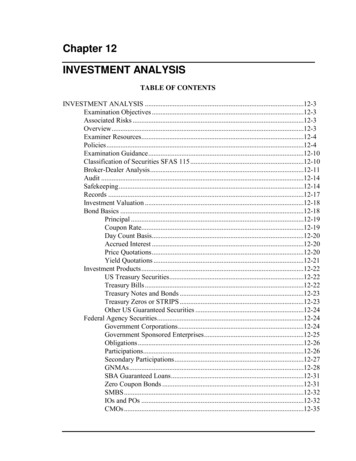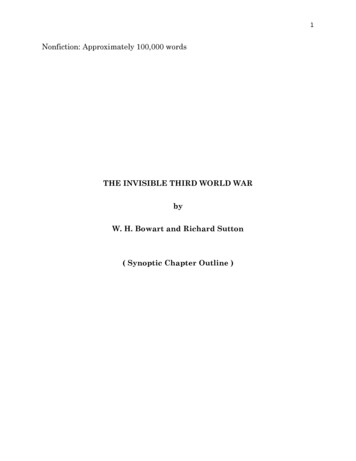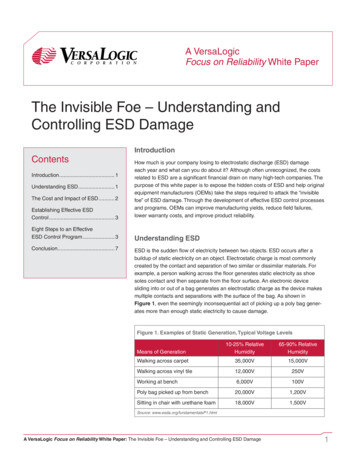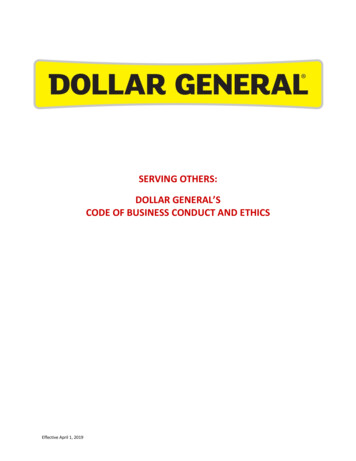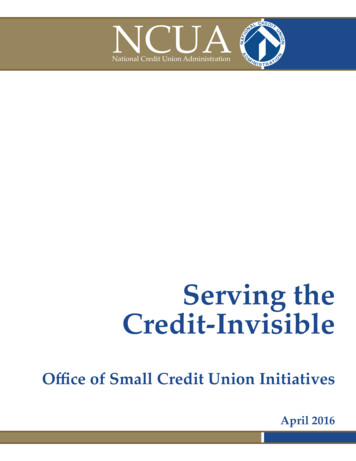
Transcription
INISTRATUONN ATNIIOCREDINMTIODNational Credit Union AdministrationALANCUANServing theCredit-InvisibleOffice of Small Credit Union InitiativesApril 2016
According to the Consumer Financial Protection Bureau, 26 million U.S. adults have no credithistory with the three national credit bureaus: TransUnion, Experian, and Equifax. As a result,they have no credit scores.Most consumers have a mix of credit activity, some “visible” and some “invisible.” Visiblecredit is reported to the credit bureau and included in the consumer’s credit score. Invisiblecredit is credit activity that is not reported to the credit bureau and, therefore, not included in theconsumer’s credit score.“Credit-invisibles” are consumers whose documented credit history is so limited that they don’thave credit scores or their credit scores are not based on a complete history of debt repayment.This is often because several of the payments types they routinely make are not reported tothe credit bureaus. Another reason some consumers are invisible is that they are new to theborrowing scene and haven’t established a credit history.But a credit invisible could actually have a good credit history, if she or he makes on-timepayments of rent, insurance, utilities or loans obtained from an organization that doesn’t report toa credit bureau. A true repayment history may not be included in their credit scores, making theirgood credit history invisible.This paper explores how credit unions can strategically tap into this underserved market and helpcredit invisible members increase their visibility in the traditional credit reporting system andbuild a good credit score.2
Table of ContentsSection 1 – The Credit Invisible. 4Who are the Credit-invisibles? . 4The Difference between Credit-invisibles and other Non-prime Borrowers. 5Why Make Loans to the Credit-invisible?. 5Section 2 – Credit Scores . 5What is a Credit Score? . 5Why is a Credit Score Important? . 6Helping Members Build a Good Credit Score. 6Section 3 – Establishing a Credit Invisible Loan Program . 7The Risks . 7The Rewards . 7Planning for a Credit Invisible Loan Program. 7Pricing. 8Net Worth Allocation. 8Training. 8Section 4 – Evaluating the Credit Invisible Loan Application. 9Developing Underwriting Guidelines. 9Basic Underwriting. 9Debt Ratios . 10Purpose of the Loan: Needs versus Wants. 10Financial Counseling . 11The Interview. 11Increasing the Probability of Repayment . 11Loan Closing Meeting . 11Section 5 – Collection Program. 12Section 6 – Loan Monitoring Program . 12Monitoring Reports. 12Credit Score Migration . 13Section 7 – Summary . 13Section 8 – Appendices. 13Appendix A – Sample Loan Underwriting Policy Guidelines. 13Appendix B – Sample Loan Application Review Worksheet. 15Appendix C – References . 163
Section 1 – The Credit InvisibleWho are the Credit-Invisibles?“Credit-invisibles” are consumers whose documented credit history is so limited they don’t havecredit scores or whose credit scores are not based on a complete history of their debt repayment.According to the Consumer Financial Protection Bureau, 26 million U.S. adults have no credithistory with national credit bureaus: TransUnion, Experian, and Equifax. As a result, theseindividuals have no credit scores. This is often because the consumer is just entering the creditworld or because several types of payments they routinely make are not reported to the creditbureaus. Payments such as rent, utilities, debts from small businesses and even debts from somesmall credit unions may not be reported to a credit bureau. As a result, those payments aren’tincluded in the consumer’s credit score.1So, while the consumer may actually have a strong history of debt repayment, the fact that thedebts she or he pays are not reported, hides the true credit history, making the consumer a creditinvisible.In May 2015, the Consumer Financial Protection Bureau released a report on credit-invisibles.The report identified: Approximately one out of every ten adults does not have a credit history with a national creditbureau: Equifax, Experian or TransUnion. More than 19 million consumers—about eight percent of the adult population—haveunscored credit records. About 9.9 million have an insufficient credit history, and 9.6 millionlack a recent credit history. Consumers in low-income neighborhoods are more likely to be credit invisible or have anunscored record. Of the consumers living in low-income neighborhoods, 30 percent arecredit invisible and 15 percent have unscored records. In upper-income neighborhoods, onlyfour percent are credit invisible and five percent are unscored. Blacks and Hispanics are more likely to have limited credit records over Whites and Asians.About 15 percent of Blacks and Hispanics are credit invisible versus 9 percent of Whites.About 13 percent of Blacks and 12 percent of Hispanics have unscorable records compared to7 percent of Whites. CFPB’s analysis suggests that these differences across racial and ethnicgroups materialize early in the adult lives of these consumers and persist thereafter.1The CFPB report also identified that young people were more likely to be labeled credit invisibleor have an insufficient credit profile to allow a credit score to be calculated. More than 80 percentof the 18–19 year olds were in this position, primarily because they have not had time to establisha credit history. The level fell to under 40 percent for the 20–24 age group.Some researchers, such as John Ulzheimer, president of Consumer Education at Credit Sesame,identified that the Credit Card Accountability, Responsibility and Disclosure Act of 2009contributed to the lack of a credit profile for young people entering the credit world. The Actmandated that, to get a credit card, people under 21 were required to obtain a cosigner or provethey had an independent income. As a result, many credit card companies ceased their formerlyCFPB Office of Research, “Data Point: Credit-invisibles,” http://files.consumerfinance.gov/f/201505 cfpb da ta-point-credit-invisibles.pdf (accessed 1 Feb. 2016).14
aggressive marketing efforts on college campuses, thus restricting the younger demographic frombuilding a credit profile. 2Other causes for people to be credit invisible include: Living in areas that do not offer credit opportunities,Borrowing from creditors who do not report to the credit bureaus,Family culture that doesn’t believe in borrowing,Cash-dependent lifestyle, andStatus as a first-time borrower.The Difference between Credit-Invisibles and other Non-prime BorrowersThis paper is not a discussion of prime and non-prime lending. However, understanding thedifference between a credit invisible and other borrowers requires an understanding of thedifference between prime and non-prime borrowers.The term “prime” refers to borrowers who represent a very low risk of default based on a creditscore. “Non-prime” refers to all other borrowers. A “non-prime” borrower with a weak credithistory (such as delinquent payments, charge-offs, judgments or bankruptcies) and a low creditscore is labeled “sub-prime.”The credit invisible does not have a credit score or has a credit score that is not based on acomplete history of debt repayment. While the non-prime borrower has a poor proven credithistory, the credit invisible’s credit history cannot be seen clearly. The credit invisible mayactually have an excellent debt repayment history—it just hasn’t been reported.Why Make Loans to the Credit Invisible?With more than 26 million credit-invisibles in America, credit unions have a potential new sourcefor lending and membership. Credit unions serving credit invisible members have an opportunityto develop a long-lasting credit relationship with them, especially if the credit union is the firstfinancial institution willing to take a chance and extend credit on reasonable terms. Making loansto the credit invisible, when done properly and well-managed, provides an opportunity for a creditunion to increase its overall yield on assets and provide a pathway to financial stability for theircredit invisible members.Section 2 – Credit ScoresWhat is a Credit Score?Calculated by the traditional credit bureaus, the credit score is a three-digit number generatedfrom an analysis of information in a consumer’s credit bureau file. The score is calculated using amathematical formula that measures the statistical probability that the consumer will default on aloan.It doesn’t take much to generate a credit score. Usually a score is generated when a consumer hasat least one account that has been reported to the credit bureau for at least six months.Kelley Holland, “45 Million Americans are Living Without a Credit Score,” CNBC, 5 May 2015, -million-have-no-credit-score.html25
Typically the credit score consists of five weighted factors: Payment history: How the consumer repays her or his reported obligations, as well as publicrecords and collection account data. Capacity: Measures revolving debt balances compared to total credit. Length of credit history: How long the active credit accounts have been opened. New credit: Assesses the number of new accounts the consumer has as well as recentinquiries into her or his credit history. Types of credit used: Considers the mix of credit when determining the score.It is also important to know what does not affect a credit score. Besides the prohibiteddiscriminatory practices of considering age, race, color, religion, national origin, sex and maritalstatus, several other elements are not included in the credit score. These include: Cash transactions;Employment information including salary and seniority;Debt ratio;Type of housing and where one lives;Interest rates and terms of the loans;Child support payments;Rent payments (in some cases);Inquiries that are not credit-related;Whether the applicant is participating in a credit counseling program; andAny information not on the credit report.Credit bureaus can only use information reported directly to them. And all credit bureaus do nothave the same information, because creditors may not report to every credit bureau. Remember,the credit score only represents the probability of repayment. It does not guarantee a loan will berepaid according to the terms.Why is a Credit Score Important?A credit score is extremely important because most lenders make lending decisions and price loanproducts based in part on the applicant’s credit score. Generally, the better an applicant’s score,the better loan rates and terms a lender will offer. Other organizations also use credit scores tomake decisions.Helping Members Build a Good Credit ScoreCredit unions can help members build a good credit score by reporting outstanding debt paymenthistories to a credit bureau. Working with a member to qualify for a loan helps to build the creditprofile. Helping the member open a credit card or other revolving type debt, whether with you oranother lender, also helps build a good score because the loans will build the capacity componentof the score. Initially, the loan may not be at the very best of terms, but if members start out withsmall loans and pay them on time, they will build a good credit score.6
Section 3 – Establishing a Credit Invisible Loan ProgramThe fact that some consumers don’t have a credit history because they don’t use credit, orthe sources they borrow from aren’t reporting to a credit bureau, makes them credit invisible.But being credit invisible does not necessarily mean they are not credit worthy. Some creditinvisibles are, some aren’t. Because of this unknown, stronger loan review processes are neededto properly assess the creditworthiness of a credit invisible applicant. Appropriate policies,monitoring and control mechanisms are essential to the success of a credit-invisible loan program.The RisksMaking loans to credit-invisibles does not come without risks. Proper due diligence and riskanalysis is essential. Typical risks associated with a credit invisible loan program include, but arenot limited to: Credit Risk of Loan Default: The lack of a credit profile makes it difficult to know the longterm credit repayment practices of a borrower or predict whether she or he will default. Thereis a risk that delinquency and loan-loss levels could increase if members don’t pay accordingto the loan terms. Liquidity Risk: Establishing a new program that supports making loans to members who donot have a credit history could result in more member referrals and increased loan demand.The increased loan demand may create a liquidity crunch. Compliance Risk: Incorporating the credit invisible into a risk-based pricing program mayrequire the credit union to provide the members with additional disclosures. Strategic Risk: The risk that goals for loan volume, loan losses, earnings and operationalexpectations are missed, resulting in a negative impact on the credit union.The RewardsIn most cases, the credit invisible borrower can get credit, but generally the lack of a credit scoreprompts lenders to charge high interest rates and offer less favorable terms. Your credit invisibleborrowers benefit from getting credit at a reasonable rate and term, and they are also building acredit file, thus helping them generate a credit score and become more “visible.”Done right, lending to the credit invisible member can generate more loans and increase theloan yield. But loans to the credit invisible member must be made with caution because there isa higher probability of loan losses. One way to mitigate risk is to start the borrower off with asmaller loan. Starting with a smaller loan allows the member to prove she or he has the abilityand the willingness to repay the loan.Planning for a Credit Invisible Loan ProgramWhen developing a credit invisible loan program, ensure the strategic and business plans definethe credit union’s financial and operational goals for the program. They should also clearlyidentify the type of loans (such as new car, used car or signature) available under the program.The plans should acknowledge the risks and provide the needed resources, including specializedmanagement and staff expertise to minimize loss exposure. Training needs should be addressedto ensure staff understands the risk associated with a credit invisible lending program, includinghow to appropriately analyze the credit risk.7
The program’s plan should clearly identify the program objectives including, but not limited to,the anticipated: Number and balance of loans to credit-invisibles,Delinquency and loan loss rate,Net loan yield,Loan growth rate over time,Membership increases,Improvements in profitability, andNet worth risk exposure.The plan should ensure adequate controls are in place to evaluate the loan portfolio quality. Itshould also identify the reports used to analyze and evaluate the program. When objectives arenot met, the board should examine the reasons and implement measures to protect the creditunion’s net worth.PricingLending to the credit invisible is typically time-consuming and can generate higher loan losses.When pricing a credit invisible loan product, take into account the additional expenses related toprocessing and servicing the loan, including, but not limited to the costs associated with the: Detailed underwriting required for this type of loan, including additional verifications ofitems on the loan application, Loan applicant interview, Credit evaluation, Financial counseling, Collection expenses, and Loan loss reserves.Once these costs are determined, price the credit-invisible loan products to cover these additionalcosts plus a contribution to the credit union’s net earnings.Net Worth AllocationPrior to implementing any lending program, the board must evaluate whether it has sufficientcapital to protect against the risks associated with the new program. The loan policy and strategicplan should identify the amount of capital allocated for potential losses and clearly state plans toadjust the lending program if those loss levels are reached.Keep in mind that loan losses do not surface immediately, but when they do, they can providevaluable information. When a loan is written off, evaluate the factors that caused the loss andwhether they are underwriting related or attributed to other factors occurring after the loan wasapproved, then adjust the program to help minimize future losses.TrainingMaking loans to the credit invisible requires trained staff able to objectively evaluate the loanapplication and identify and analyze the applicant’s invisible credit history. Establish a strongtraining program focused on the specialized non-traditional underwritin
In May 2015, the Consumer Financial Protection Bureau released a report on credit-invisibles. The report identiied: Approximately one out of every ten adults does not have a credit history with a national credit bureau: Equifax, Experian or TransUnion. More than 19 million c
